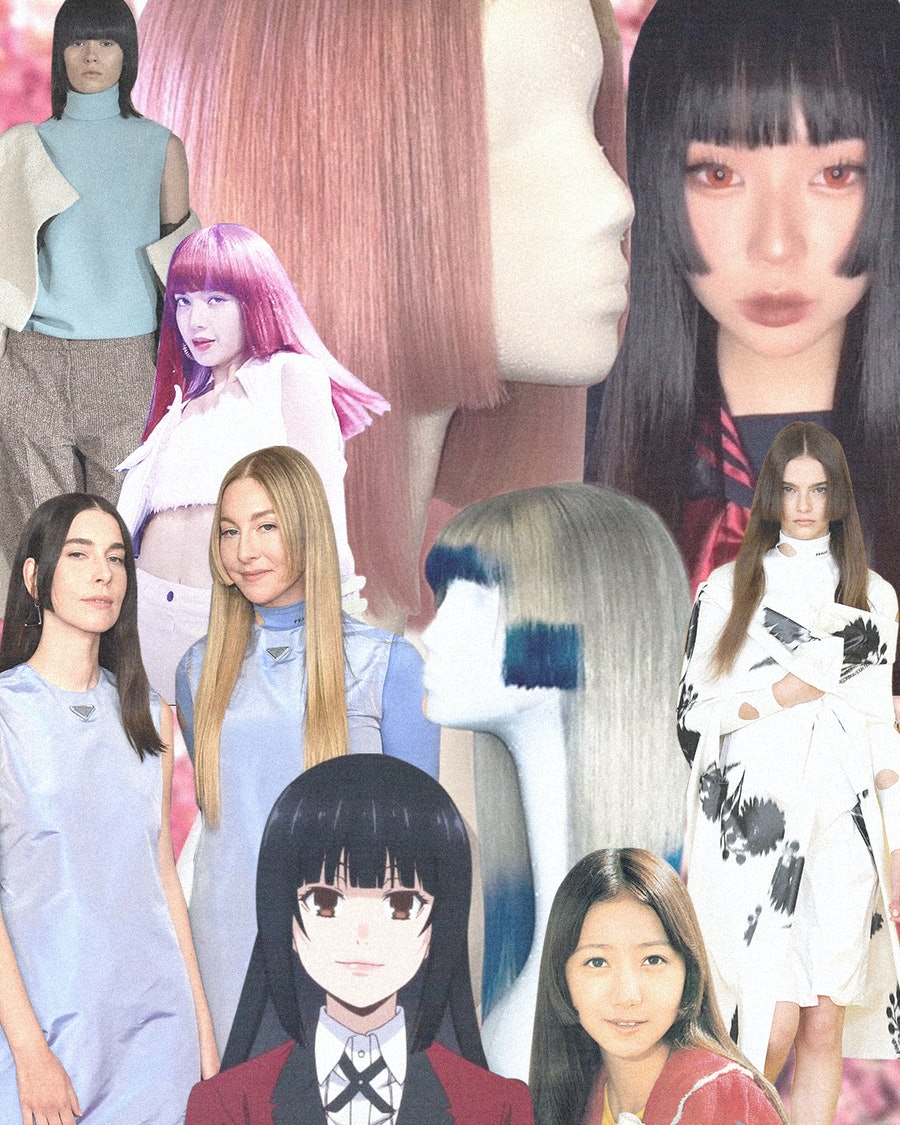Collage by Tilden Bissell for W magazine, images courtesy of @freakybeautiful, @ninachaan, Kevin Mazur/Getty Images for The Recording Academy, Victor Company of Japan LTD, Netflix, Blackpink, Prada, and Valentino.

What do Prada’s spring 2021 show and Haim’s looks at the Grammys have in common? The Hime haircut. This hairstyle, which is fast becoming one of the coolest looks both in real life and on the Internet, consists of straight, typically cheek-length side-locks and a frontal fringe—the rest of the hair is usually worn long and straightened. Even if you haven’t heard of the style by name before, you’ve probably seen it. On TikTok, the Hime tag has over 122.6 million views, with many people going in for the chop DIY style. There are haircut tutorials, as well as transformation reveals. And the Instagram account WeiWesleyWei has racked up over 40k followers (with industry insiders like the designers Mowalola and UglyWorldwide following the account) for posts on almost exclusively Hime cuts.
Some people have also been calling it anime hair, inspired by their favorite characters—including Yumeko Jabami from the movie Kakegurui—Compulsive Gambler. The style is thought to have originated, or at least became more common, in the Imperial court during the Heian Period of Japanese history, when noble women would sometimes grow out their hair for their entire lives.
“The Hime, or princess cut, is named for the noblewomen who would have originally worn the style and was popularized during the Heian period of Japanese history, 794 to 1185,” explains the hair historian Rachael Gibson. “It combines two styles: longer hair at the back, with blunt, shorter sections on either side at the front. These shorter front lengths would have been cut during the ceremony of Binsogi; an event that celebrates coming of age with a haircut. The combination of these two cuts led to a new style: Hime.”
But why is the Hime cut trending at this very moment? Over the past few years, there has been a major focus on the mullet and all of its modifications; there were all versions of the modified mullet at Prada spring 2021, in different lengths. But many from the cast of first-time models sported the Hime cut, which is an extreme version of a mullet, with a dramatic short angle in the front and long layers swept to the back.
Plus, the 1970s are trending in fashion—look no further than Miu Miu’s colorful polos and mini skirts, Tom Ford’s floral prints and YSL’s cool suiting. The hairstyles from that time period—shags, mullets, and curtain bangs included—are coming back, too, Gibson explains. “The Hime look was really popular in the 1970s thanks to the influence of popstar Megumi Asaoka,” she says.
But in reality, the look is entirely of the now. “In a broader sense, I think a lot of people are just really excited about getting interesting haircuts after a year in lockdown,” Gibson adds. “We often see interesting haircuts happen after key moments in history—daringly short hair for women in the 1920s after the First World War, punk cuts in the 1970s. Today, if you're keen to try something new but you don't want to lose all your length in one go, this is a great stepping stone—plus, it has Zoom impact which is something we're all considering way more now.”
For Guido Palau, the stylist behind the mullet hairstyles at Prada and Valentino, the Hime moment is successful because “it was considered bad taste.”
“We love to reinvent something that was really frowned upon to wear at the time [of its popularity],” he says. “I think the new generation doesn’t know that kind of hair from the 1980s, they’re reacting to what they're doing and seeing now. Something about it has a very light and rebellious feeling.”
Another thing to note about the Hime cut: its major versatility. You can wear your hair up with short pieces hanging down for the illusion of short hair, or you can tuck the short pieces behind your ears and pull the longer parts forward for a more blended look. Celebrities like Taylor Swift have worn much softer versions of the Hime cut, and K-pop stars have tried to look—Blackpink’s Lisa included. This flexibility is a hallmark aspect of Gen Z, and according to Palau, might be one of the main reasons the haircut is experiencing virality.
“It’s fluid in its sexual identity,” Palau says. “Girls and boys and anyone in between can sport it in their way. It could be super classic or it can be choppy and punky, or with really short bangs. The fact that it’s ambiguously genderless, I think, is very appealing to people now.”












